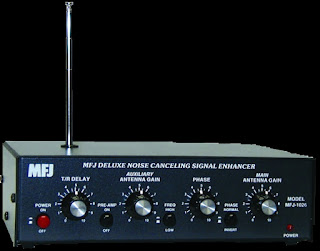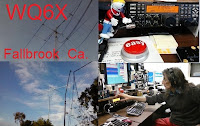This was followed by last weekend's minimal show in the NAQP Cw contest, operating portable from W7AYT's QTH. This weekend again found me running portable from W7AYT - test-driving a couple of new ideas hardware-wise.
 |
| RTTY/SSB audio cable |
Well, audio is audio - what works for AFSK should be even better for SSB. Using VOX, N1MM+ played .WAV files flawlessly.
For once I was setup well in advance of the start of NAQP - the trickiest part being the creation of .WAV files to be played by the N1MM+ function keys.
During previous NAQP's because I am only allowed to operate 10 out of the 12 contest hours, I tend to forgo the first contest hour on the premise that the high bands may not be open enough by 18:00z to be worthwhile.
Because we are nearing the bottom of the sunspot cycle, for this year I decided to take a reverse approach - starting as close to 18:00z as possible - on the theory that the high bands may well shutdown earlier in the afternoon.
 |
| Space WX be-4 NAQP |
As it turns out, because of recent solar storms I probably should have stuck to the usual plan.
Working W0ZYT (Alex) in North Dakota on 20 meters @ 17:45z (with S-9 reports both ways) led me to conclude the rest of 20 meters would follow suit - NOPE.
 |
| CH-250 Vertical & Cobra sloper |
The space WX reports prior to the contest were bleak, at best (as you can see in the picture above). However predictions don't always dictate individual band openings.
The portable setup I erected at W7AYT consisted of the now usual run of a Yaesu FT-1000mp into either Dennis' CH-250 vertical as well as an 8Mh sloping-V cobra antenna I hang before the contest starts.
The FT-1000mp sports an excellent A/B antenna switching mechanism along with built-in memories to "remember" which antenna works best for each band.
While I was able to tune the CH-250 on 160 meters (as I did in NAQP-Cw), altho I could hear many strong stations, Saturday evening, unlike last weekend, they could not hear me.
Because band condx were so poor I decided to take the 1st 1/2 hour break @19:32z, before returning to 15 meters, netting as many QSOs as possible while the band struggled to hold up.
Slow QSB (fading) made that a difficult task, resulting in only 23 QSOs (the same as last weekend's 15-meter figure).
Later in the day due to continued poor bay area condx. I inadvertently went an entire hour w/o QSOs, qualifying as another hour in the total off period. It don't matter how you doit, as long as you doit. Fining yet another 1/2 hour during dinner then allowed me to run the contest to the 06:00z end time.
 |
| SO2V in action |
The 1000mp even allows the operator to switch the audio to opposite ears . It recently occurred to me that a psychological benefit of SO2V is that it somewhat relieves the boredom-factor during slow frequency run periods.
However, it is important to ALWAYS give priority-attention to the RUN frequency (VFO-A) over VFO-B. If I get too confused, I immediately turn off VFO-B until I have the equipment and/or run frequency back under control.
Late Saturday afternoon when 20 meters abruptly took its final dive I moved down to 40-meters (7185.85) hoping 40 and 80 would salvage the low QSO rate.
At 00:30z K9RM in Indiana said I was very strong; which because of the heavy slow-QSB turned out to bring false hope. The incessant QSB seemed to ruin openings almost as soon as they started. It seemed that the lower bands were "late" in opening and then quickly went "long".
During the last hour of the contest, the iBoost keyboard (with large yellow keys) began malfunctioning, it would seem, shortly after I made a worthless attempt at 160-meter contest activity; altho the two events may not be related.
In summary, I think the main thing that can be said about this weekend's NAQP contest can be summed up thus: K-Index = 3 ==> 4. As a result, the solar noise was incessant - albeit sporadic;
more on 40-meters than anywhere else. What I don't understand is how the space WX app on DXMAPS.Com can report that there was/is a solar storm, and yet an hour later, WWV's + :18 forecast detailed that NO space weather storms were observed for the last 24 hours.
HuH? I thought the space WX app got its data from WWV/WWVH. Am I missing something?
 |
| NAQP Ending Statistics |
When it was all over my 160 contacts resulted in barely half the previous weekend. Luckily, W6TK and W6AFA did a superb job carrying team #1.
While this year's NAQP SSB affair was filled with frustration, there were pockets of fun throughout. Working NP2X & KP4CPC, along with VY1MB & XK150YUKON in the Northern Territories using the Cobra-sloper made it all worthwhile.
Because I chose to run frequencies a lot, it was quite a thrill to have stations pop-in out of nowhere, resulting in a new multiplier. I also noticed that MANY "0" call area stations were identifying themselves as "Tod" in honor of K0TO(sk). Tributes like this make radiosport contests more personal.
This winter California is receiving its share of rainfall so staying inside to work a radiosport contest made a lot of sense to me. The more I operate SO2V, the more comfortable I become doing it.
Thus far, the FT-1000mp has given WQ6X nearly 18 months of unparalleled portable contest operation. I love any opportunity to sit down and spin the radio's REAL knobs,
in addition to running the Yaesu via computer (CAT) control.
Did YOU play in this weekend's NAQP SSB contest?
Is WQ6X in YOUR log?






































